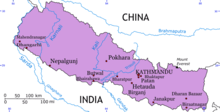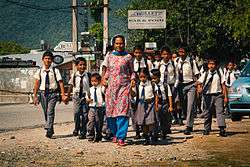Education in Nepal
Education in Nepal was long based on home-schooling and gurukulas.[1] The first formal school (Durbar School), established by Jung Bahadur Rana in 1853, was intended for the elite. The birth of Nepalese democracy in 1951 opened its classrooms to a more diverse population.[1] Education in Nepal from the primary school to the university level has been modeled from the very inception on the Indian system, which is in turn the legacy of the old British Raj.[2]
 | |
| Ministry of Education | |
|---|---|
| Minister of Education | ...... |
| National education budget (2006) | |
| Budget | $98.64 million |
| General details | |
| Primary languages | Nepalese |
| System type | Central |
| Established | Education Act August 9, 1971 January 28, 2004 |
| Literacy (2011) | |
| Total | 65.9% |
| Male | 75.1% |
| Female | 57.4% |
| Enrollment | |
| Total | 6,373,003 |
| Primary | 4,030,045 |
| Secondary | 2,195,8352 |
| Post secondary | 147,123 |
| Attainment | |
| Secondary diploma | 46.2% |
| Post-secondary diploma | Unavailable |
| 1Source: Ministry of Education website 2Includes lower secondary, secondary, and higher secondary | |

Nepal's 1971 education plan hastened its development in the country.[1] In 1951 Nepal had 10,000 students in 300 schools and an adult literacy rate of five percent.[1] There were 49,000 schools in 2010,[1] and by 2015 the overall adult literacy rate was 63.9 percent (males 76.4 percent and females 53.1 percent).[3] It has already been more than half decade that public schools started imparting the education in the country. Curriculum developed in the country is not oriented towards the practical education. Public schools are criticized for not being able to provide quality education. Lower-caste discrimination, and indigenous bias are now the primary barriers to equitable access to education. After thorough review of secondary literature, analysis through macro perspective under the influence of critical pedagogy, the following problems were identified: lack of physical and infrastructures, textbooks, a unified national curriculum, monolingual instruction, and a lack of constructive and critical pedagogical strategies. Furthermore, poverty and social exclusion are the major factors contributing to poor performance.[1]
Administration
The Ministry of Education is responsible for managing educational activities in Nepal. The Minister of Education (assisted by the state or assistant minister) is the political leader of the ministry. The ministry, as a part of the government, is headed by the Secretary of Education and consists of a central national office and other offices at the regional and district levels. The central office is primarily responsible for policy development, planning, monitoring, and evaluation.
The ministry has established directorates in each of the five development regions and education offices in each of Nepal's 76 districts to bring educational administration to the people. These decentralized offices are responsible for overseeing local informal and school-level educational activities. Regional directorates are primarily responsible for coordinating, monitoring and evaluating educational activities, and the district education offices provide services.
The National Center for Educational Development (NCED) [4] is Nepal's teacher-training body. It has 34 educational training centers (ETCs) to provide pedagogical support for teachers.
Nepal has two primary types of schools: community and institutional. Community (public) schools receive government grants, and institutional (private) schools are self-funded. Institutional schools are non-profit trusts or companies.
With one exception, all universities and academies are publicly managed and supported by public funding. Public universities also provide affiliation to private colleges. Academies of higher education are typically single-college institutes, and universities have constituent and affiliated colleges across Nepal.
Structure

Primary education in Nepal called Basic Education consists of grades one through eight. Secondary levels are grades nine to twelve. Pre-primary education is available in some areas, and students usually begin grade one at age five. A Basic Level Examination (BLE), previously known as District Level Examination (DLE), is given on grade eight while a national Secondary Education Exam (SEE), previously known as School Leaving Certificate (SLC), is examination is conducted at the end of grade 10, while completing the Grade 12 examination leads to the School Leaver's Certificate. The National Examinations Board (NEB) supervises all BLE, SEE and 12th grade exams.
University education leads successfully to the degrees of bachelor, master and doctor (Ph.D). Depending upon the educational stream and degree subject, a bachelor's degree may require as much as three to five years of study, but two years is the typical duration. Some universities offer M.Phil. and post-graduate diplomas.
Vocational education begins after lower secondary education, and students can follow a two-year curriculum leading to a Technical School Leaving Certificate.[5] Universities also offer professional and technical degrees. In addition to the formal track, one-year programs focusing on skills development are also available.[5] The District Level Examination is given in grade eight. The new educational system has two levels: basic (grades one through eight) and secondary (grades nine through twelve).
Crises and illiteracy
Although the Jhapa District with 99.33% literate in 2014 [6] many children in remote villages do not have access to education past the primary level.[7] Sociologists have identified the Chepang people the "poorest of the poor" in Nepal.[8] Students often leave primary schools after they learn to read and write, but without additional education these skills may be forgotten.[7] The April 2015 earthquake and 2015 blockade destroyed schools and severely impacted the nation's ability to keep its remaining schools open.
Textbooks
Government schools use Janak textbooks, and private schools use reference books such as Green, Koseli, Ekta, Read More, Reliant, Asia, and Vidyarthi. Government schools perform poorly in the SLC exam, presently SEE exam, due to the lack of skilled teachers, textbooks, and the Ministry of Education's neglect of textbook reform.
Tertiary Education
Universities
Nepal's first college was Tri-Chandra College, founded in 1918. Until 1985, Tribhuvan University was the country's only university. During the early 1980s, the government developed the concept of a multi-university system in which each school would have its own nature, content, and function.
The first new university was Mahendra Sanskrit University. It was followed by Kathmandu University (the first private university) in 1990 and Purbanchal and Pokhara Universities in 1995 and 1996, respectively.
Medical colleges
Medical colleges, mostly private, exist throughout Nepal. Local students are admitted after an entrance exam, and foreign students are admitted after an interview. To be eligible for admission to MBBS courses in Nepal's medical colleges, students must pass the higher secondary examination in science or its equivalent. Medical education is regulated by the Medical Council of Nepal. In addition to accrediting the country's medical colleges, the council conducts the licensing examination for new doctors, makes policies related to curriculum, admission, terms and examinations and makes registration recommendations.
Engineering colleges
Engineering colleges also exist throughout Nepal, with most admitting local students through an entrance exam. Like the country's medical colleges, foreign students are admitted after an interview. To be eligible for admission to Nepalese engineering colleges, candidates are encouraged to pass the Intermediate in Science or have a diploma in engineering (or its equivalent).
The Institute of Engineering of Tribhuvan University is the country's oldest engineering school. It has four colleges, and 13 private engineering colleges are affiliated with it. The IOE's central campus (Pulchowk Campus) as well as Kathmandu university school of engineering are considered to be the best engineering college in Nepal. Pulchowk offers bachelor's, master's and Ph.D. degrees in engineering. More than 16,000 students from around the world take the school's entrance examination.
Nepal Engineering College (NEC) in Changunarayan is the country's first private engineering college to offer bachelor's- and master's-level courses. Popular engineering fields in Nepal are architecture, civil engineering, computer engineering, electronics and communications, electrical and electronics, energy and rural engineering. The B.E. architecture courses take five years to complete, and other bachelor's-degree courses take four years.
Study abroad
Nepal ranks 11th in countries of origin for international students in the United States. According to "Open Doors 2009", the annual report on international academic mobility published by the Institute of International Education with support from the Bureau of Educational and Cultural Affairs of the United States Department of State, the number of Nepali students enrolled in U.S. institutions of higher education increased from 8,936 in the 2007–08 academic year to 11,581 in 2008–09 (a 29.6-percent increase). In the 2006–07 academic year, Nepal ranked 13th among countries of origin of international students.
According to Terry J. White, counselor for public affairs at the U.S. Embassy in Kathmandu, "America's nearly 3,000 accredited schools of higher education continue to attract new students in what is becoming a highly competitive international 'market' around the world." The U.S. is the preferred destination for students from Nepal who want to study abroad because of the quality and prestige associated with an American degree. Another contributing factor is access to comprehensive, accurate information about study in the U.S. through EducationUSA offices in Nepal and increased activity by United States colleges and universities to attract students from Nepal. However, "a culture of disrespect" for humble Nepalese by U.S. Embassy staff has been reported by a co-founder of Nepali/American NGO, Possible Health.[9]
See also
- Gender inequality in Nepal
- Human rights in Nepal
- List of schools in Nepal
- List of engineering colleges in Nepal (intake capacity of engineering colleges)
- List of universities and colleges in Nepal
References
- Deepak Raj Parajuli , Tapash Das. "Performance Of Community Schools In Nepal : A Macro Level Analysis" (PDF). International Journal of Scientific and Technology Research. Retrieved 9 July 2014.
- "Education System in Nepal".
- "CIA world Fact book". The World Factbook. CIA. 2015.
- "National Center for Educational Development".
- "World TVET Database Nepal - Vocational Education in Nepal" (PDF). UNESCO-UNEVOC / Council for Technical Education and Vocational Training Nepal. January 2014. Retrieved March 18, 2018.
- {{site web| url= https://moe.gov.np/category/reports.html%7C
- "Kathmandu Post- Children in Chitwan deprived of education past primary level".
- Beine, Caughley and Shrestha. 2012. Chepang Then and Now: Life and Change Among the Chepang of Nepal. Blurb Books.
- Maru, Duncan (August 2, 2017). "Culture of Disrespect Plagues US Embassy in Nepal". HuffPost. Retrieved March 18, 2018.
External links
- Ministry of Education, Nepal
- World data on Education: Nepal, UNESCO-IBE(2010-2011) - Overview of the Nepalese education system
- Vocational education in Nepal, UNESCO-UNEVOC - Overview of the Nepalese vocational education system
- "Bringing the Poorest into Schools", World Bank (2009)
- - Report on higher education and TVET in Nepal, Asian Development Bank (2016)